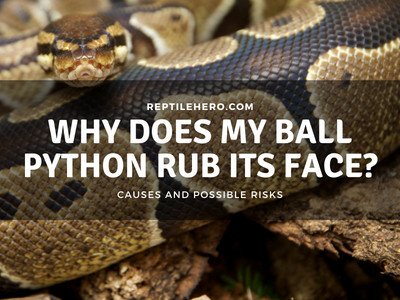Why is Your Ball Python Head Shy? (Handling a Shy Snake)
Whenever we try to pet our ball pythons in their heads, they tend to move and hide their heads away from us. Why are ball pythons so sensitive every time we touch this part of their body?
Generally, ball pythons are naturally head shy, as a survival instinct. A ball python hides its head to protect itself from potential predators because it is the most vulnerable part of its body. Younger ball pythons tend to be more head shy than adults.
What does it mean when ball pythons hide their heads away from us during handling sessions? Why don’t they like being touched on their head and neck? Continue reading to discover why your snake is head shy and what you can do about it!
What Makes a Ball Python Head Shy?
Head shyness is natural in ball pythons. It is one of their survival mechanisms. Ball python hides its head, the most vulnerable body part, away from predators. Moreover, younger ball pythons are more head shy than their adult counterparts.

A ball python is typically head shy due to the vulnerability of its head. Your ball python’s head consists of eyes, heat pits, nose, mouth, and other vital body parts responsible for basic but essential functions such as breathing, eating, thinking, etc.
Imagine what your ball python would be without its head. How would they survive without it? After all, snakes use their heads to aim, neutralize, and eventually kill their prey.
If you are going to approach a newly hatched ball python, you may see that the young snake is either too aggressive or hiding its head as if it is trying to protect itself. Being head shy is engraved in their instincts when these snakes come out of their eggs.
We appear larger to smaller snakes, and this makes us pose a threat to younger ball pythons. Due to their size, younger ball pythons tend to be more head shy than adult ones.
Hatchling ball pythons often hide their heads while hissing at the potential predator. But sometimes, even passing by on a newly hatched ball python makes the snake assume a striking position.
How to Handle a Head Shy Ball Python? (7 Simple Steps!)
When dealing with a head shy ball python, a keeper must 1) be quiet, 2) not make any sudden movements, 3) start from the tail up to the mid-body, 4) slowly introduce the palm, 5) use the fingers to extend the snake’s slithering path, 6) gently touch the snake’s nape, and 7) touch the head from behind.
1. Be Quiet
Before handling your head shy ball python, make sure that your surroundings are quiet. Be silent when approaching your ball python’s enclosure and handling your pet.
Our ball pythons can hear sounds through vibrations [1]. Being quiet around your snake can help you in gaining your shy ball python’s trust.
>>Learn more about reptile hearing in our article on gecko sound sensitivity.
2. Don’t Make Sudden Movements
Place your shy ball python in your lap and wait for your ball python to get comfortable and uncurl itself. Ball pythons uncurl themselves when they start to feel comfortable with their surroundings.
While waiting, you must be quiet and don’t make any sudden movement. Ball pythons are sensitive when it comes to sudden movement. So if you or someone around is not careful enough, your ball python might hide its head, and you might have to wait for your snake to un-ball itself again.
3. Start From the Tail Up to the Mid-Body

Once your head shy ball python uncurls itself and starts exploring, slowly stroke its tail gently. Make sure that you are stroking the snake along the scales’ direction, as going against them makes the snake uncomfortable.
>>Find out whether your pet reptile likes being stroked in our article on petting.
Rushing to touch your shy snake’s mid-body or head may startle it and might make it start curling itself up again. You have to wait for your snake to get comfortable with its tail being handled. Then, slowly work your way up until the mid-body.
4. Slowly Introduce Your Palm
Ensure that your ball python is comfortable and relaxed while it is being touched and handled. Once your snake is accustomed to general handling, you can start to place your palm under its neck without touching it.
If contact happens, your snake might draw its head away during this step, but you have to be patient. If your ball python moves its neck away from your palm, you can stop and try again after a few minutes.
Make your palm be your ball python’s slithering path without grabbing onto its neck. The key is to make your snake realize that your hands are not threatening.
Keep introducing your palm during handling sessions until your snake considers it as its path and crawls on top of it.
5. Use Your Fingers
Once your ball python is confident in crawling on your palms, you can start to use your fingers. Use your fingers as “extensions” for your snake’s slithering path and let your pet crawl between your fingers.
You can slowly narrow the gaps between your fingers during this process until you feel your ball python’s head. Being too tight may result in discomfort for your ball python.
If your snake jerks its head away during this process, you can stop for a few minutes and try again. The general rule is to never force your snake.
6. Gently Touch its Nape
Once your ball python is comfortable exploring around your fingers, you can now gently touch your snake at the back of its neck. You can lightly touch its nape using only your thumb or your whole hand.
You can stop this process for a few minutes if your snake tries to move its head away. If you find your ball python roaming around your fingers again, try touching the back of its neck from time to time.
During handling sessions, continue doing this step until your touch no longer fazes your ball python on its neck and nape.
7. Touch the Head from Behind
Touch your ball python’s head from behind. At this point, your snake must be conditioned to accept handling and tolerates neck and nape touching.
Approach your snake’s head from behind. Why from behind, you ask? Approaching your ball python from the front or side of its head might result in your snake perceiving you as a threat, and because of this, you may get bitten by your reptile pet.
The entire process of gaining the trust of your ball python takes time and patience. So don’t be discouraged if you didn’t earn the trust of your slithering pet right away.
You must be very gentle when it comes to handling your ball python. Your snake should associate your scent with safety and security.
Can Your Ball Python’s Head Shyness be Solved?
In general, regular handling can significantly reduce the head shyness of ball pythons. Dealing with the stuck shed or medical treatment for a ball python is much easier if the snake is less head shy.

Ball pythons don’t like being touched in their head. It doesn’t feel natural for a ball python to be touched in its head. However, regular handling and patience can help reduce your ball python’s head shyness.
Each handling session may help your snake in developing trust in you. Once your ball python learns that you are the smell that brings water and food and gently handles and hangs out with it regularly, your snake might grow less head shy.
Regular handling of your head shy ball python could help make your snake more friendly towards you.
Why should you assist your ball python in overcoming head shyness?
Overcoming your ball python’s head shyness could be beneficial for you and your snake. Less head shy ball pythons are easier to deal with if it has a stuck shed that needs to be removed or treated for diseases (e.g., mouth rot, respiratory infection, etc.).
>>Learn more about stuck shed in our article on shedding problems.
Further Questions
How long will head shyness last in ball pythons?
Some ball pythons grow out of their head shyness, while others do not. With that being said, there is no exact time frame for how long a ball python would be head shy. It all depends on the snake keeper’s effort and time that he will allot to make his reptile comfortable around him.
What does it mean when a ball python raises its head?
If you see your ball python raising its neck while looking forward, it is called “periscoping” because the snake forms a periscope shape. This behavior may appear when your snake is exploring or when being handled. Ball pythons use this technique to survey the vicinity as they move.
Summary of Why Ball Pythons are Head Shy
As a general rule, ball pythons are head shy. One of the ways ball pythons survive in the wild is through head shyness. Because its head is the most vulnerable part of its body, a ball python hides its head to protect it from potential predators.
A keeper must gently touch the snake from the tail up to the mid-body. Once the shy ball python is accustomed to its body being handled, the owner could start to use his fingers as its path to “unintentionally” touch the snake’s head and eventually help the snake overcome its head shyness.
Regular handling can significantly reduce the head shyness of ball pythons. Moreover, removing a ball python’s stuck shed or applying for medicine in the area is much easier if the snake is less head shy.
Source
[1]







